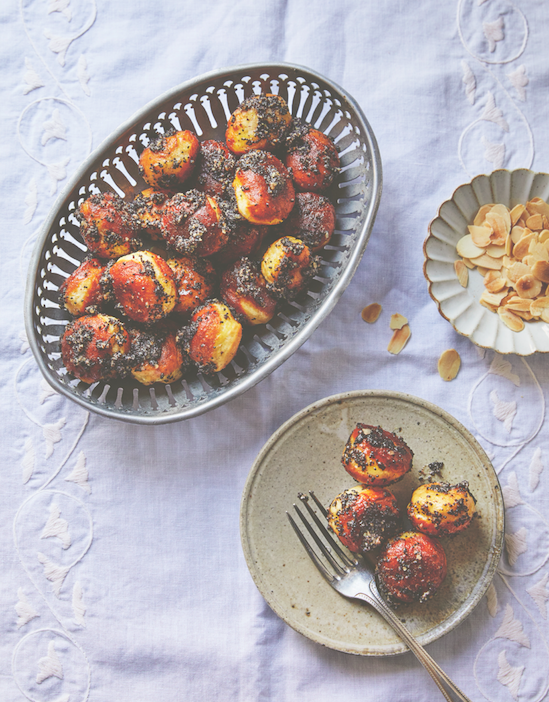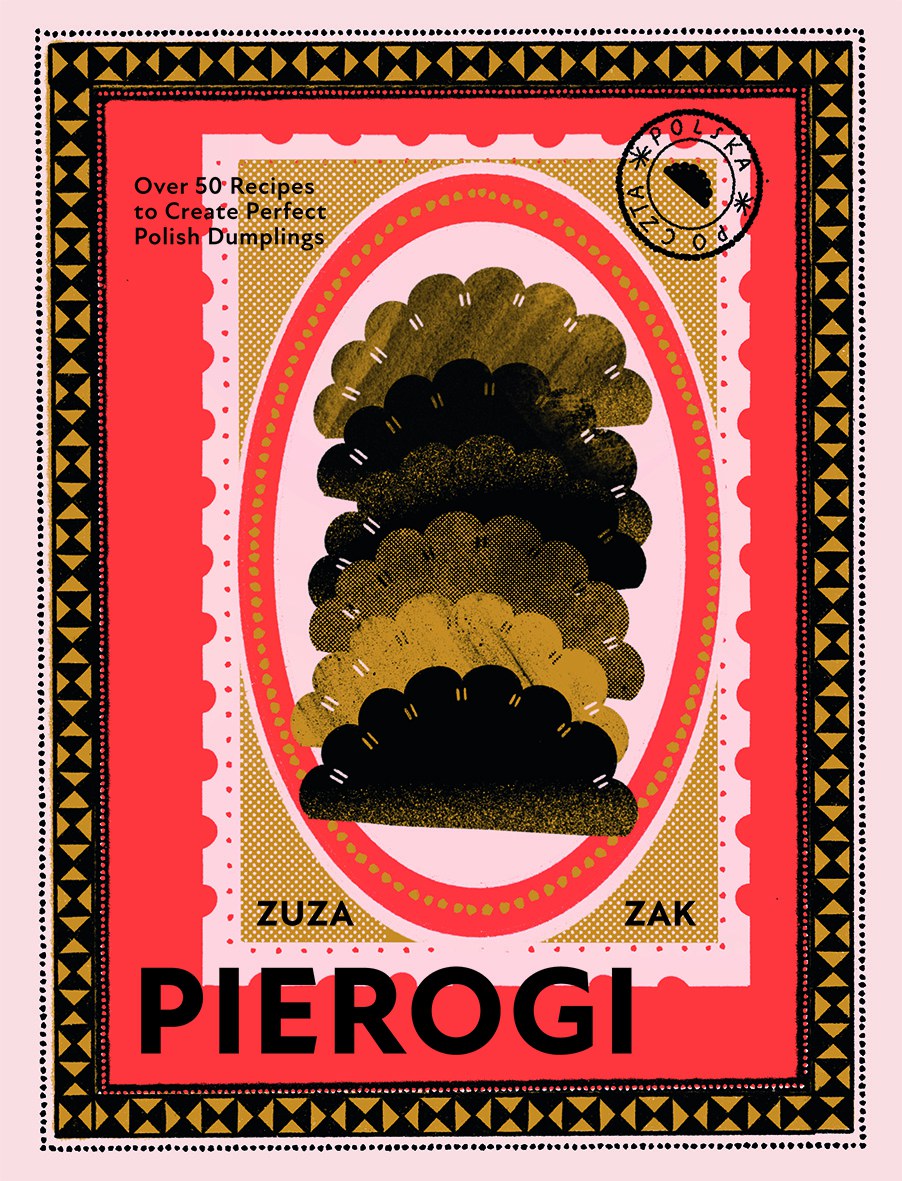Born of peasant food, the Polish pierogi has taken its place as the country's signature staple. On a quest to prove that Polish food was more than just dumplings, food writer and cook Zuza Zak came in her own words, full circle, and what materialized was a new book dedicated to the pillows of comfort. Her book is “Pierogi: Over 50 Recipes to Create Perfect Polish Dumplings.”
This interview has been edited for length and clarity.
KCRW: What is your earliest memory of making pierogi?
Zuza Zak: It was on the ninth floor of my grandma's communist bloc. I grew up in communist Poland until I was eight. Her kitchen was tiny – it barely fit two people. But she was there. She was actually a cook by profession, but also she would cook food for all her extended family. She had four children, and all their families, and then all her neighbors as well. We had these feasts at her house. So she would make huge amounts of food. She spent such a long time in this kitchen and I would often help her make pierogi. But having small hands, she often had to take the pierogi off to me and pinch it again just to close it because it's very difficult for little children to close them properly.
Is there a very traditional filling that is found everywhere in Poland that people would find surprising?
In Poland year-round and in the diaspora, the most popular filling would be the pierogi ruskie – which are now being renamed in Poland as Ukrainian because that is actually more accurate as to where they were said to have come from. They are filled with farmer's cheese, caramelized onion, and cooked potato.
How do perogies vary regionally throughout Poland? Does landscape figure into the fillings or seasonality?
Absolutely. So in the summer, everywhere around Poland, you'll find a blueberry pierogi – made with wild blueberries we find in the forests. You'll often find people sort of selling it by the roadside that have been picking in the morning. So that's the most popular summer one. On Christmas Eve, everyone will have sauerkraut and wild mushroom pierogi – people might just have mushrooms but on the whole, most people will have sauerkraut mushrooms on the table. However there are also lots of regional varieties as well. So for example, in the mountains, you might have pierogi with fresh cabbage and bacon. In Poland you would use bryndza cheese, which is a sheep's milk cheese, but you can use feta instead. So it's very very similar. In the north where you're by the Baltic Sea, you would find fish pierogi is very common.
Once you have perogies and you've cooked them, and they float to the top of the simmering water, and you've skimmed them and put them in a bowl, is sour cream and melted butter the all-purpose topping for most of them?
Sour cream goes with most pierogi because it just goes so well with the dough. For me personally, I would put them in the butter bath, and then fry them a little bit as well. The sweet ones, especially with sour cream, are a must. With the savory ones, you can have sour cream but not always – there's various different toppings. The most typical one is caramelized, slightly crispy onions. Some people would have a bit of bacon in there. One of my grandma's would always just have little baked, crispy bacon bits with any kind of dumpling apart from the sweet ones. Obviously, everyone has their own favorite ones.
Recently, I went to a new pierogi joint in Warsaw. They had crispy fried celeriac, which we've never had before. But I thought that's a really interesting vegan option. I think anything kind of caramelized and crispy on top works pretty well. With the sweet ones, I just go quite wild actually. With any kind of chocolate pierogi, I like a greater bit of chocolate on top. Honey goes really well on all the sweet ones as well.
Leave us with a couple of festive ideas since holidays are coming up in the not- too-distant future.
The first one that comes to mind – because Nigella Lawson picked to feature it, so I'm really proud of this recipe now – is deep fried dessert dumplings with rum and poppy seeds. They're almost like little doughnuts covered in this rummy, poppy seed mixture. It has that kind of quality of, of a Polish Christmas – it's sort of that kind of decadence and the poppy seeds are so traditional, they have been used since pagan times really, and all kinds of sort of festive rituals. Actually, my auntie remembers something like this being hung in bags on the Christmas tree.
Sauerkraut and mushroom Christmas Eve pierogi
Serves 4
These are an old, traditional pierogi, and so here I suggest an old, traditional method of making the dough: rubbing the oil into the flour first, which seems to be the preference of elderly babushkas.
They say that the Italian influence felt in Polish cooking led to the use of eggs in the dough and that just using oil or butter is more traditional. However, you can use any dough you prefer from any of the recipes in this book, for these dumplings, instead of the one used here.

Poppy seeds, used since pagan times and said to offer protection and promote fertility, they are featured with rum in a dessert pierogi. Photo by Ola O. Smit.
Ingredients
For the filling
- 20 medium-sized mushrooms
- 1 tbsp salted butter, plus 2–3 tbsp extra,
- melted, to serve
- 1 onion, finely chopped
- 150g (51⁄2oz) sauerkraut, drained
- 1 bay leaf
- 1⁄4 tsp allspice berries
- splash of white wine (about 2 tbsp)
- salt and white and black pepper, to taste
For the dough
- 300g (101⁄2oz/21⁄4 cups) plain (all-purpose) flour, plus extra to dust
- large pinch of salt
- 1 tbsp cold-pressed rapeseed (canola) oil 150–160ml (5–51⁄4fl oz/about 2/3 cup)
- warm water (from a pre-boiled kettle)
Instructions
- Rinse the mushrooms under running water, then put them in a heatproof bowl and pour over boiling water to cover, so that they open up. Rinse under running water once more, put in a heatproof bowl and pour over boiling water to cover again. This time, leave them to soak for at least 2 hours (or overnight), then dice finely. Transfer to a large saucepan and sieve in the soaking liquid. Cook over a medium heat for about 30 minutes.
- Meanwhile, heat the butter in a frying pan and fry the onion over a low-medium heat, stirring, until caramelized, 10–15 minutes.
- Add the sauerkraut, bay leaf, allspice and wine to the pan with the mushrooms and when they’re ready, add the caramelized onion. Continue to cook, stirring from time to time over a low heat, for a further 45–50 minutes.
- If the mixture sticks to the bottom, add another splash of wine (not too much, as there should be no liquid left at the end of cooking). Once ready, turn the heat off, taste and season. Cover and allow to cool to room temperature. Remove (and discard) the bay leaf and allspice berries.
- To make the dough, put the flour and salt in a bowl and pour in the oil slowly while using your fingertips to rub it into the flour. Keep rubbing with your fingertips for a few minutes. Then start adding the measured warm water, while bringing the dough together. Once it all comes together (you may not need all the water), knead it on a floured surface for 6–7 minutes until it becomes elastic, but not sticky. Cover with a clean, damp dish towel and allow to rest for 20–30 minutes.
- Roll the dough out thinly (about 0.5mm is ideal) and use your preferred method to shape, fill and seal the pierogi (see pages 12–19). Place them on a floured surface with space between each one.
- Bring a large pan of salted water to the boil. Cook the pierogi in batches. Once they float to the top, give them an extra 2 minutes, then remove with a slotted spoon, shake off any excess water, and transfer straight into a warm dish with the melted butter in it, making sure they are well coated. If need be, you can keep them warm in a low oven for 30 minutes or so.
Excerpted with permission from “Pierogi” by Zuza Zak, published by Quadrille.
Deep-fried dessert dumplings with rum and poppy seeds
Serves 4
This recipe has a complicated history. My friend from Switzerland managed to procure it and I find it fascinating, as it apparently has roots in Warsaw, but it reminds me of southern Polish/Slovak cuisine. It simply goes to show how much variety there is from one household to the next. I have adjusted the recipe only slightly from the instructions passed on to me, reducing the poppy seed quantity.
Ingredients
For the topping
- 200g (7oz) poppy seeds
- 20g (3⁄4oz) caster (superfine) sugar
- 50g (13⁄4oz) flaked almonds, lightly toasted
- 40g (11⁄2oz) walnuts, crushed
- 2 tbsp raisins, soaked in 50ml (3 tbsp) dark rum 20g (3⁄4oz) butter
- 4 tbsp good-quality runny honey
For the dough
- 125ml (4fl oz/1⁄2 cup) milk, warmed
- 15g (1⁄2oz) fresh yeast or 7g (1⁄4oz) dried
- 60g (21⁄4oz) caster (superfine) sugar
- 220g (73⁄4oz/about 11⁄2 cups) plain (all-purpose)
- flour, plus extra to dust pinch of salt
- 1 egg, lightly beaten
- 1 tsp vodka
- 1 tsp vanilla extract
- rapeseed (canola) oil, for frying
Instructions
- Wash the poppy seeds under running water, then put them in a large pan, pour over fresh water to cover by about 2.5cm (1in) and bring to the boil. Turn down the heat and simmer for about 20 minutes – it should be bubbling a little on the surface. Turn the heat off and leave, covered, overnight. If there is any water left in the pan after cooling, drain it away.
- The next day, put the warm milk in a small bowl, add the yeast, sugar and 1 tablespoon of the flour. Mix well, cover with a clean dish towel and leave in a warm place for about 30 minutes, or until the mixture has doubled in size. (This leavening mixture is known as zaczyn.)
- Meanwhile, transfer the poppy seeds to a food processor and blitz until they release a milky substance and become one, light-grey mass, about 10–15 minutes. Towards the end of the blending process, add the sugar, most of the almonds (reserve a handful for decoration) and all of the walnuts and raisins (along with the rum) and blitz until well combined but still with some texture. Spread this out onto a large plate.
- Transfer the zaczyn to a large bowl, add the rest of the flour, the salt, egg, vodka and vanilla extract and mix well with your hands. Cover again and leave to rest in a warm place once more to rise (about 30 minutes).
- Heat about 1cm (1⁄2in) of oil in a large frying pan.
- Turn the dough out onto a floured work surface and knead, incorporating just enough flour
- so that the dough can be rolled out without sticking. Use an upturned shot glass to cut little circles of 4–5cm (11⁄2–2in) in diameter. Re-roll the dough as necessary; you should have enough dough for about 20 circles.
- Fry the dough circles in the hot oil in batches. They should puff up with hollow insides. Once golden, remove using a slotted spoon and drain on a plate lined with paper towels.
- Melt the butter and honey in a small saucepan. Brush it all over the dumplings, then roll them in the poppy seed mixture to coat. Sprinkle with the reserved almonds and serve warm.
Excerpted with permission from “Pierogi” by Zuza Zak, published by Quadrille.

Food writer Zuza Zak was raised in communist Poland until she was 8-years-old and remembers making pierogi on the ninth floor of her grandmother’s tiny kitchen. Photo by Ola O. Smit.

“Pierogi” celebrates the national dish of Poland, with recipes for both sweet and savory dumplings. Photo courtesy of Quadrille.
